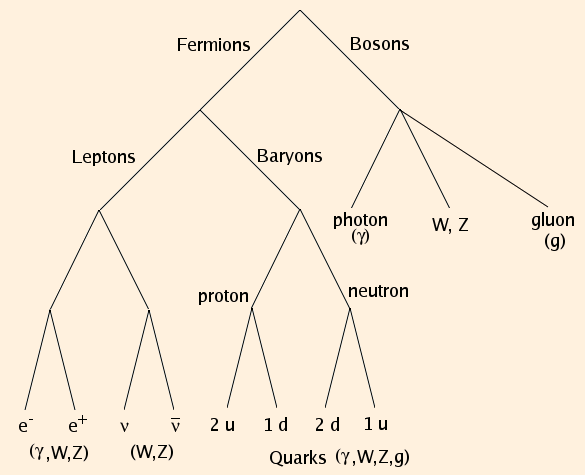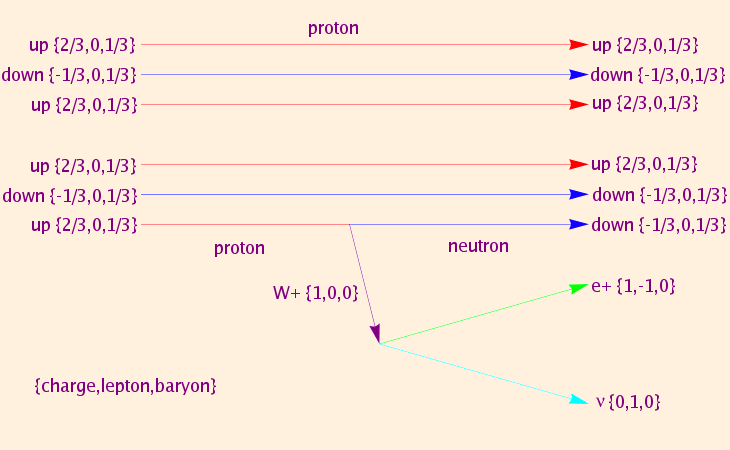
We will assume that electrons, protons and neutrons are reasonably familiar. If not, all we really need to know before we continue is that atoms are made of them, the electron is negatively charged, the proton is positively charged, and the neutron is neutral.According to the Standard Model, the fundamental particles of matter are all either leptons or quarks. Both types of particle are fermions: particles which have spin 1/2 or - 1/2 and obey the Pauli Exclusion Principle, which states that no two can be in the same state at the same time. The theory further posits that the three fundamental forces of nature: electromagnetism, the weak force, and the strong force (excluding gravity for the moment), are mediated by particles called gauge bosons. The notion is that a force is felt between two charged particles when a gauge boson is exchanged between them. They have spin +-1, so they are not fermions, and do not obey the Pauli Principle:

There are two main types of leptons: electrons and neutrinos (ν). Except for the neutrinos, all quarks and leptons carry electrical charge and exchange photons, which mediate the electromagnetic force. All left-handed quarks and leptons can exchange W and Z bosons, which mediate the weak force. (A particle is left-handed when its spin is parallel to its magnetic moment.) The weak force allows one type of quark to change into another, or an electron to change into a neutrino (or vise versa). Only the quarks can exchange gluons, which mediate the strong force, and hold quarks together. Individual quarks are never seen; they are always found as a bound pair called a meson, or a bound triplet called a baryon. The most common baryons are protons and neutrons. The strong force is about 13.7 times stronger than the electromagnetic force. The weak force is weaker by a factor of 10,000 than the strong force, although it is not the weakest: gravity is 1036 times weaker. Gravity only appears to be so strong because of the sizes of the sources of the gravitational field: planets, stars and galaxies.
There is also antimatter; for each fermion, there is an associated antiparticle. An antiparticle is identical to its ordinary "partner" in every way except its charge and helicity (whether its spin is parallel or antiparallel to its momentum). The antiparticle associated with the electron is the positron (e+). It is expected that issues involving handedness and helicity will ultimately explain why there is more matter than antimatter in the observable universe.
Consider the following reaction, which lies at the heart of the nuclear reactions powering our Sun, as well as all main sequence stars:
1H + 1H -> 2H + e+ + νe"1H" denotes a proton: this Hydrogen nucleus has no accompanying electron to make it an atom because the intense heat (over 10 million K) necessary to allow fusion to occur has stripped the electron off, making it an ion. "2H" denotes a Deuterium nucleus, which consists of a proton and a neutron, bound by the strong force. The subscript on the neutrino indicates that it is specifically an electron neutrino: the weak partner to the electron, and not to a muon or tau particle (which are heavier leptons).
To understand this reaction, we need to know the quark content of the proton and neutron. The proton is made up of 2 "up" quarks and 1 "down" quark (up and down are just labels), bound by the strong force. The neutron is made up of two down quarks and one up quark, similarly bound. The up quark is usually assigned an electric charge of +2/3, and the down a charge of -1/3, of the magnitude of that of the electron. This makes the electric charge "come out even": we call this conservation of charge.
Now that we have discussed all the pieces of the Standard Model that we will need, this diagram may help to put everything in perspective:

So what really happened in our fusion reaction was that one up quark turned into a down quark, via the emission of a W+ boson (which then decayed into a positron and a neutrino):

This allowed the resulting neutron to be bound to the remaining proton, making the Deuterium nucleus. But because there were no leptons on the left hand side of the reaction, there must be none on the right: the positron, with lepton number -1, plus the neutrino, with lepton number +1, add up to 0 leptons. We call this lepton number conservation. Since protons and neutrons are both baryons, we also have baryon number conservation in this reaction.
The extra energy that is released in this reaction comes from the fact that the combined mass of the products is lower than the combined mass of the reactants. This mass difference is equivalent to energy through Einstein's famous equation
E = m c2and comes about because the binding energy of the resulting Deuterium nucleus is negative. Differences in binding energies also account for the excess energy released in fission.
| Experiment | Theory |
|---|---|
| 1814 - Fraunhofer discovers absorption spectra | 1913-5 - Bohr explains them quantum mechanically |
| 1845 - Leverrier measures the perihelion shift of Mercury | 1916 - Einstein explains using General Relativity (GR) |
| 1887 - Michelson and Morley determine c is a constant | 1905 - Einstein explains with Special Relativity |
| 1893 - Eotvos determines Minertial = Mgrav | 1916 - Einstein incorporates this into GR as the Equivalence Principle |
| (1800s) - measurements of black body radiation | 1900 - Planck derives black body distribution |
| 1929 - Hubble discovers the expansion of the universe | 1933 Robertson finds GR solution for expanding universe |
| 1965 - Penzias and Wilson discover Cosmic Microwave Background Radiation (CMBR) | |
| 1965 - Rubin begins measuring galaxy rotation curves | no consensus yet on what dark matter is |
| 1998 - Filippenko and Riess discover the expansion of universe is accelerating | no consensus yet on what dark energy is |
When a theoretical scientist has one of those very rare, remarkable strokes of insight, and sees the existing data in a new and fundamentally more complete way, it is possible for the conclusions of the theory to drive the search for new experimental data:
| Theory | Experiment |
|---|---|
| 1916 - Einstein formulates General Relativity | 1920 - Dyson, Eddington and Davidson report gravitational deflection of light |
| 1960 - Pound and Rebka measure gravitational red shift | |
| 1969 - Jenkins measures gravitational time effects | |
| 1978 - Taylor and Hulse measure energy loss in binary pulsars due to gravitational waves | |
| 1980 - Hubble Space Telescope discovers gravitational lensing | |
| 1916 - Schwarzschild discovers spherical vacuum solution to GR (describes black holes) | no direct evidence yet |
| 1917 - Einstein proposes Cosmological Constant | 2007 - 5 years of WMAP data favors nonzero Cosmological Constant |
| 1921/6 - Kuluza and Klein propose extra dimensions | no evidence yet |
| 1930 - Dirac predicts antimatter | 1932 - Anderson discovers the positron |
| 1931 - Fermi predicts the neutrino | 1956 - Reines and Cowan discover it |
| 1961 - Gell-Mann and Ne'eman explain particle zoo using quark model | 1974 - Richter and Ting discover the J/ψ |
| 1963 - Kerr discovers vacuum solution to GR with angular momentum | 2007 ? - Gravity Probe B searches for frame dragging |
| 1967 - Glashow, Weinberg and Salam formulate Electroweak theory | 2013 - we seem to have a Higgs! |
| 1972 - Gell-mann develops Quantum Chromodynamics (QCD) | no contradictions yet... |
| 1974 - Pati and Salam formulate first Grand Unified Theory | no evidence yet |
| 1975 - Hawking proposes that black holes emit radiation | no evidence yet |
| 1971 - Ramond, Neveu and Schwartz formulate Supersymmetry | no evidence yet |
| 1975/81 - Scherk, Green and Schwarz develop String Theory | no evidence yet |
| 1981-2 - Guth, Linde, Albrecht and Steinhardt propose inflation models | no contradictions yet... |
| 1986 - Ashtekar develops loop quantum gravity | no evidence yet |
Note: Electroweak theory and QCD are incorporated into the Standard Model.
It is hoped that this little "experiment vs. theory" reality check will clarify some of the ideas presented in the public forum in a properly scientifically conservative light.
©2014, Kenneth R. Koehler. All Rights Reserved. This document may be freely reproduced provided that this copyright notice is included.
Please send comments or suggestions to the author.